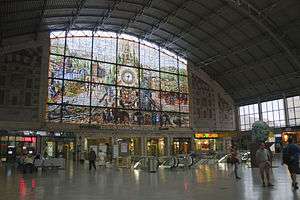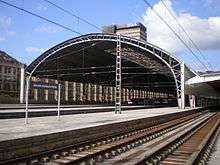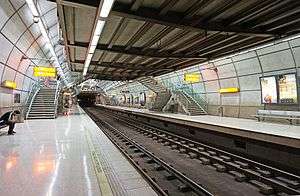Bilbao-Abando railway station
The Abando Indalecio Prieto railway station (Basque: Abandoko Indalecio Prieto geltokia, Spanish: Estación de Abando Indalecio Prieto) also known simply as Bilbao-Abando and previously known as Estación del Norte (North Station) is a terminal railway station in Bilbao, Basque Country (Spain). The name comes from Abando, the district in which the station is located, and Indalecio Prieto, who was Minister of Public Works during the Second Spanish Republic. The station serves as the terminus station for several long and medium distance services operated by Renfe as well as commuter rail services within the Bilbao metropolitan area operated by Cercanías. The station has direct access to Metro Bilbao and to Bilbao's Tram, as well as many local and regional bus lines. The railway station Bilbao-Concordia, operated by Renfe Feve is located in close proximity. After the construction of the high-speed line Basque Y is finished, Bilbao-Abando will serve as the western terminus, which will involve the creation of a completely new station replacing the current one.[3][4]
Bilbao-Abando Indalecio Prieto | |
|---|---|
| Terminal station | |
 Stained glass at the station's upper hall | |
| Location | 1, Gran Vía 48001 Bilbao Spain |
| Coordinates | 43°15′41″N 2°55′40″W |
| Owned by | Adif |
| Line(s) | Casetas–Bilbao railway Renfe long-distance services Cercanías Bilbao: |
| Platforms | 2 side platforms (main lines) 3 island platform and 1 side platform (Cercanías) |
| Tracks | 8 |
| Connections | Metro Bilbao, Bus, Tram |
| Construction | |
| Structure type | At-grade station |
| Platform levels | 1 |
| Parking | Yes |
| Disabled access | Yes |
| History | |
| Opened | 1870 |
| Rebuilt | 1948 |
| Traffic | |
| Passengers (2018) | 6,494,565[1] |
| Rank | 31[2] |
History
The first station was opened on the 1 March 1863 with the opening of the Bilbao-Orduña railway line; at that time Abando was still an independent municipality and not part of Bilbao. That first line was intended to continue south to connect Bilbao with Castile after a railway junction in Miranda de Ebro, and it was eventually expanded to reach Castejón, near the city of Tudela.[5] The company commissioned with the works of the new line was called Company of the Railway from Tudela to Bilbao, led by Charles Blacker Vignoles, who gave it a clear English style.[6] In 1865 the company filed for bankruptcy and was intervened by the Bank of Bilbao[7] In 1878 it was transferred to the Company of the Railways of Northern Spain, company that owned the line and stations until the nationalisation of the Spanish railways in 1941, when it was integrated into Renfe and renamed Bilbao Abando station.
Due to the poor situation of the station's building, Renfe commissioned the construction of a new station on its place, which finally opened in 1948.[8] The station was affected by the 1983 floodings of Bilbao, after which it was partially renovated with the addition of escalators and sculptures by Agustín Ibarrola. The building underwent several modifications and renovations in the following years, including the opening of a shopping mall and the creation of two extra rail tracks after the integration of the Cercanías Bilbao commuter-rail services, which until then had the closed Bilbao-La Naja station as their terminus.
In 2006 the station was renamed Abando Indalecio Prieto station, after Indalecio Prieto, who was Minister of Public Works during the Second Spanish Republic. The renaming caused controversy,[9] although the change was not reflected on the service maps and the service announcement systems of the trains, which still use Bilbao-Abando. In 2010 it was announced that the station would become the northwestern terminus of the Basque Y high-speed line and as such would need to go through extensive renovation works.[3] In 2018 the Ministry of Development and the city hall of Bilbao jointly announced the project for the new Bilbao-Abando station, which would involve the construction of a completely new station with three underground levels, one for the high speed trains, another for the regional and Cercanías trains and a main hall. The station will be connected to a new bus station with 13 platforms as well as the existing metro station.[4] The constructions works are expected to begin in 2020 and cost 730 million Euro, with railway services starting in 2023. The entire urbanisation project including infrastructure and housing could be finished around 2030.
Station layout

The Bilbao-Abando station has two separate main spaces. The main hall building is U-shaped and has five floors. It was built as part of the 1948 renovation using reinforced concrete combined with granite, limestone and brick to provide the building with a monumental appearance. The second building is an annex to the main one and has a semi-circular shed with 12 arches. One of the most singular aspects of the station is the stained glass that overlooks the train platforms. It is composed of 301 pieces and it is 15 metres wide and 10 metres tall and it was made in 1948 by Jesús Arrechubieta following a sketch by Miguel Pastor Veiga.[10] The glass depicts diverse activities typical of the Biscayan society, as well as emblematic places such as the Basilica of Begoña.
The ground and first floors of the station hold restaurants, gift shops and other services while the third floor holds the rail tracks and platforms as well as other railway-related services.
Access




Railway services
The station has traditionally served long-distance and commuter-rail Cercanías services. The station has the peculiarity of not having any regional medium-distance services, something unusual for a terminus station located in a city of the size of Bilbao. This lack of services is compensated by the close proximity of Bilbao-Concordia and Zazpikaleak/Casco Viejo stations, which offer local and regional services to the cities of Santander, León and San Sebastián.
Long distance services
The long-distance services concentrate all the non-local passenger services in the station. There are three main lines serving at the station.
| Preceding station | Renfe Operadora | Following station | ||
|---|---|---|---|---|
Miranda de Ebro toward Madrid Chamartín | Alvia | Terminus | ||
Miranda de Ebro toward Barcelona Sants | Alvia | |||
| Laudio toward Vigo-Guixar |
Intercity | Terminus |
In addition, two former lines called at this station before shutting down:
| Preceding station | Renfe Operadora | Following station | ||
|---|---|---|---|---|
| Miranda de Ebro toward Málaga María Zambrano |
Estrella "Picasso" closed in 2012 |
Terminus | ||
| Laudio toward Salamanca |
Diurno "Iberia" closed in 2012 |
Terminus |
Local services
Bilbao-Abando is the main hub of Cercanías Bilbao, a commuter-rail network operated by Cercanías, which is part of Renfe. Cercanías offers rapid-transit services between central Bilbao and other municipalities across the its metropolitan area, with services similar to that of a metro network but with fewer stops.
| Preceding station | Cercanías Bilbao | Following station | ||
|---|---|---|---|---|
| Terminus | C-1 | Zabalburu toward Santurtzi | ||
| C-2 | Zabalburu toward Muskiz | |||
| C-3 | Miribilla toward Orduña |
Rapid transit
 Platforms and tracks | |
| Location | 1 Gran Vía de Don Diego López de Haro 48001 Bilbao Spain |
| Owned by | Metro Bilbao S.A. |
| Line(s) | |
| Platforms | 2 side platforms |
| Tracks | 2 |
| Construction | |
| Structure type | Underground station |
| Platform levels | 1 |
| Parking | No |
| Disabled access | Yes |
| Other information | |
| Fare zone | Zone 1 |
| History | |
| Opened | 5 July 1997 |
Besides the long-distance and local services, Bilbao-Abando is also connected to the Abando metro station, which is a station of line 1 and line 2 of Metro Bilbao. It is an underground station located outside of the Bilbao-Abando railway station, but nevertheless connected to it directly. It opened on July 5, 1997.
Abando station follows the typical cavern-shaped layout of most underground Metro Bilbao stations designed by Norman Foster, with the main hall located directly above the rail tracks.
The station can be accessed from:





Other services
Bilbao-Abando is located in close proximity of the Bilbao-Concordia railway station which is part of the narrow-gauge Renfe Feve network with local services to Balmaseda and Karrantza as well as regional services to Santander and León. Bilbao-Abando is connected directly to Bilbao-Concordia via a pedestrian access. The Zazpikaleak/Casco Viejo station is located at around 600 metres from Bilbao-Abando. This station is operated by Euskotren Trena and from there trains run to Durango, Elgoibar and San Sebastián.
The Abando stop of Bilbao's Tram, operated by Euskotren Tranbia is located on Navarra street at about 200 metres from the Bilbao-Abando station. The tram connects the district of Abando with Ibaiondo and Basurto-Zorroza.
Bus services
The station is served by the following local Bilbobus services. A 'G' in the line name denotes a Gautxori night line service.
- 10 Elorrieta - Plaza Circular
- A1 Asunción - Plaza Circular
- A2 Solokoetxe - Plaza Circular
- A5 Prim - Plaza Circular
- G2 Otxarkoaga - Plaza Circular
- G3 Larraskitu - Plaza Circular
- G4 La Peña - Plaza Circular
- G5 San Adrián / Miribilla - Plaza Circular
- G6 Zorrotza - Plaza Circular
- G7 Mina del Morro - Plaza Circular
- G8 Arangoiti - Plaza Circular
The station is also served by the following regional Bizkaibus services, running to other municipalities within the Bilbao metropolitan area or elsewhere in Biscay.
- A2314 Bilbao - Erandio Goikoa - UPV/EHU
- A2322 Bilbao - Astrabudua - UPV/EHU
- A2324 Bilbao - UPV/EHU (through Enekuri)
- A3115 Bilbao - Santurtzi
- A3122 Bilbao - Barakaldo - Sestao - Errepelega
- A3136 Bilbao - Barakaldo - Santurtzi
- A3144 Bilbao - Barakaldo (through Ugarte)
- A3151 Bilbao - Stz. - Portugalete (A-8)
- A3336 Muskiz - Bilbao (through Ortuella)
- A3340 Muskiz - Abando - Bilbao (A-8)
- A3514 Bilbao - Zornotza - Gernika
- A3515 Bilbao - Zornotza - Gernika - Bermeo
- A3521 Bilbao - Hosp. Sta. Marina
- A3911 Durango - Lemoa - Galdakao-Usansolo Hospital - Bilbao
- A3912 Eibar - Lemoa - Galdakao-Usansolo Hospital - Bilbao
- A3917 Zeanuri - Lemoa - Galdakao-Usansolo Hospital - Bilbao
- A3925 Ubide - Otxandio - Lemoa - Bilbao
References
- "Adif - Información de estaciones - Bilbao Abando Indalecio Prieto". ADIF. Retrieved 3 September 2019.
- "Atocha Cercanías lidera las estaciones de tren en España con más de 270.000 viajeros al día". Tribuna de Salamanca (in Spanish). 3 April 2019. Retrieved 2 September 2019.
- Igea, Octavio (8 March 2018). "La nueva estación de Abando que acogerá el TAV costará 480 millones" [The new Abando station that will house the HSL will cost 480 million]. El Correo. Bilbao. Retrieved 12 October 2018.
- "The new Abando station will have three floors and 550 parking spots". Deia. Bilbao. 8 March 2018. Retrieved 12 October 2018.
- Peris Torner, Juan (9 March 2012). "Railway from Tudela to Bilbao". Spanish Railways. Archived from the original on 24 September 2018. Retrieved 1 November 2018.
- "Industrial heritage". Hiru. Basque Government. Retrieved 1 November 2018.
- "History of Tudela-Bilbao". Aferioja. Asociación de Amigos del Ferrocarril de La Rioja. Archived from the original on 23 June 2010.
- "Abando Indalecio Prieto Station" (PDF). Adif. Archived from the original (PDF) on 26 September 2011.
- "The name of the station criticised". El Diario Vasco. San Sebastián. 19 September 2006. Retrieved 1 November 2018.
- "Abando Station". Industri Ondare eta Herri Laneko Euskal Elkartea (IOHLEE). 2009. Retrieved 2 November 2018.
See also
| Wikimedia Commons has media related to Bilbao Abando Indalecio Prieto train station. |